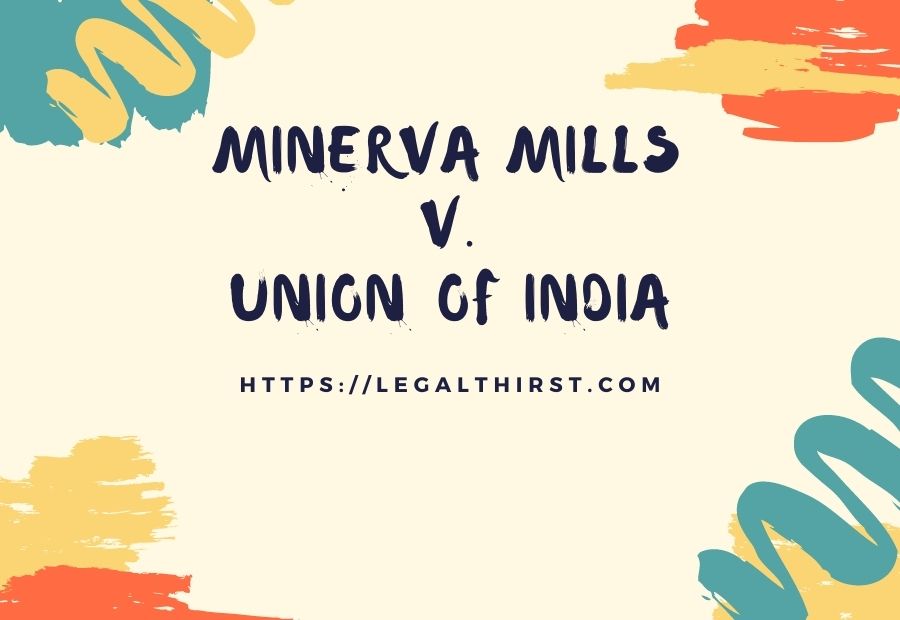This Case Comment on Minerva Mills Versus Union of India, 1980; is written by Kashish Goyal. She is Content Writer & Legal Researcher at Legal Thirst.
“CONSTITUTIONAL VALIDITY OF SOME PROVISIONS OF CONSTITUTION AMENDMENT ACT AND SUPREMACY OF FUNDAMENTAL RIGHTS OVER DIRECTIVE PRINCIPLES OF STATE POLICY WERE CHALLENGED”
| PETITIONER | Minerva Mills Ltd. & Ors. |
| RESPONDENT | Union of India & Ors. |
| JUDGES | Y.V. Chandrachud (CJ), P.N. Bhagwati, A.C. Gupta, N.L.Untwalia , P.S Kailasam , JJ |
| COURT | The Supreme Court of India |
| DATE OF JUDGMENT | 31 July 1980 |
| CITATION | 1980 AIR 1789, 1981 SCR (1) 206 |
| STATUTES | The Constitution of India, The Sick Textile Undertaking (Nationalization ) Act 1974 |
| PROVISIONS | Article 14 Article 19 Article 31 C Article 368 (Clause (4) & (5)) Section 4 and 55 of 42nd Amendment Act 1976 |
Table of Contents
Facts
Minerva Mill is a textile mill; which is situated in the state of Karnataka and owned by the petitioner in this case. The management of the mill was taken over by the central government under the Sick Textile Undertaking (Nationalization) Act, 1974. After this, In 1970, The Central government appointed a committee under section 15 of the Industries development Act 1951; to make full investigation about the affairs of the mill; and make a report as according to them there had been a substantial fall in production. Later in 1971, the committee submitted its report to the central government .A body was formed under the Industries development act 1951 named “National Textile Corporation limited”, the central Government on the basis of the above report authorized this corporation to take over the management of the mills.
The petitioner challenged the Constitutional validity of Section 55 and 4 of 42nd Amendment and 39th Amendment Act.
The Petitioner also challenged the validity of clause (4) and (5) of Article 368.
Statutory Provisions
Article 31 C which is amended states that; any law made which gives effect to the policy towards securing the state shall not be void on the ground; that it violates our fundamental rights which is protected under Article 14 or 19 of Indian Constitution.
Another amendment in Minerva mills case which is made in Article 368 by adding of clause (4) and (5) which states that; there is no limitation on the parliament to amend by addition or repeal of any provisions of the constitution or any amendment to the constitution will not be questioned in any court (Section 55 of 42nd Amendment Act 1976).
Section 4 of 42nd Amendment Act 1976 states that Directive principles of State Policy have primacy over the fundamental rights.
As per the 39th Amendment Act 1975 states that the said act i.e. Nationalization was included in the 9th Schedule by Entry 105; and which is outside the purview of the judicial review.
Issues: Minerva Mills v. Union of India
- Constitutional Validity of Section 4 and 55 of 42nd Amendment Act, 1976 which leads to changes in Article 368 and Article 31 C ?
- Whether the changes which are made through amendment damages the basic structure of the Indian constitution ?
- Whether the directive principles of the State policy have primacy over the Part III of Indian Constitution ?
Arguments of the Petitioner
- The Judgment given in Keshavananda Bharati clearly states that the Parliament cannot destroy the basic structure of the constitution.
- The directive principles of the State policy are the ends which can only be achieved by the means; which are mentioned under Part-III of the Constitution.
- No court has the power to review the amendment made by the parliament as per the Section 55 of 42nd Amendment Act 1976 and further this will destroy the balance between Judiciary and the Parliament.
- If in case the Article 31 C remains valid then it will confer an unrestricted license both at Center and state level to destroy the democracy.
- If we give absolute supremacy to one i.e. directive principle of state policy then it will disturb the harmony of the Constitution. And This harmony between fundamental rights; and directive principles of state policy is an essential feature of the basic structure of the constitution.
- A disbalance would create between fundamental rights and directive principles of state policy.
Arguments of the Respondent
- Any harm caused to fundamental rights for the purpose of welfare of the people won’t amount to destruction of the basic structure of the Indian Constitution.
- If we want to achieve the goals which are enshrined under Part- IV then there should be no restriction on power of amendment .
- This issue is too wide and in the interest of academics which should not be decided by the court.
- Article 31 which is amended is valid as it comes within the purview of Article 368.
- Any law which fulfils the directive principles is incapable of destroying the fundamental freedoms as; that structure is itself based on the principle of justice-socio, economic and political.
- To achieve the goal under Part-IV , Parliament should be supreme.
Judgement
The Court observed that Section 4 and 55 of 42nd Amendment Act, 1976 is beyond the amending power of the parliament or void as it damages the basis structure of the Indian Constitution or also takes away the rights which is granted under Article 14 and 19 of Indian constitution .Also The Court state that the Parliament has the power to amend but it should be within the basis or essential features of the Indian Constitution.
If we give Supremacy to Part-IV then it would destroy the goal which is to achieve; i.e. to maintain harmony between Directive principles of state policy and fundamental rights.
Article 31 C is unconstitutional as it damages the basic structure by not challenging the law; which gives effect to the directive principle even if they are contradicting our fundamental rights granted under Article 14 and 19.
It is the constitution which is supreme not the parliament. Parliament itself derives the authority from the Constitution which also includes the Amending power under Article 368. Thus, clause (4) and (5) of Article 368 is unconstitutional as conferring an unlimited amending power is destructive of the basic structure of the Constitution.
Held
IN MINERVA MILLS v. UNION OF INDIA; THE ARTICLE 31 C AND CLAUSE (4) AND (5) OF ARTICLE 368 ARE UNCONSTITUTIONAL AND VOID. ALSO SECTION 4 AND 55 OF 42ND AMENDMENT ACT 1976 ARE VOID AND UNCONSTITUTIONAL.
Conclusion
It is concluded that; any law which is made should not destroy the basic structure of the Indian Constitution and to maintain a balance between fundamental rights; and the directive principles of state policy is the main aim of the constitution which all the citizens should maintain. The power to amend any provision in the constitution is not unlimited; it should be within the essential features of the Constitution.
Disclaimer: The opinions and views in the articles and research papers published on this website; are personal and independent opinions of the author. The website is not responsible for them.
Legal Thirst has created a telegram group for exchanging legal knowledge, Events, and various opportunities.
You can click on this link and join:
Follow Legal Thirst on Instagram and Subscribe to our YouTube channel for more amazing legal content.



